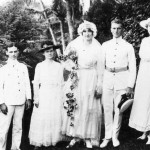THIS DAY IN HISTORY
April 7, 1917: America’s entry into WWI
- Photo shows Karl and Eleanor Gebhart, Germans who were married in Guam to the tunes of the 30-piece Cormorant band. (MARC)
- Photo shows the SMS Cormoran, which was scuttled in Apra Harbor on April 7, 1917, the same day the U.S .Congress approved Woodrow Wilson’s request for a declaration of war against Germany. Photo courtesy of Micronesian Area Research Center. (MARC)
In the years following the Spanish-American War of 1898 and the partition of the Mariana Islands, the U.S. naval governor of Guam in Hagåtña and the German district officer of the Northern Mariana Islands on Saipan gradually fell into their roles as custodians of their respective indigenous populations and representatives of their home governments. Life in the Marianas was peaceful—in the least. That all changed dramatically when Archduke Francis Ferdinand, heir-apparent to the Austro-Hungarian throne, was assassinated in Sarajevo on June 28, 1914.
On July 28, Austro-Hungary declared war on Serbia and dominoes set in place by previously unknown “secret alliances” began to fall. Germany declared war on Russia on Aug. 1. England declared war on Germany on Aug. 4. That same day President Woodrow Wilson declared America’s neutrality. Nonetheless, the Mariana Islands became involved in the European war when, on Aug.7, 1914, the British government officially asked Japan for assistance in destroying the German Far Eastern fleet in and around Chinese waters. Japan formally declared war on Germany on Aug. 23, 1914. The Japanese Imperial Navy responded and captured Saipan in October. Suddenly, the naval governor of Guam found his island in the midst of a world at war.
Capt. William J. Maxwell, then naval governor of Guam, declared Guam’s neutrality on Aug. 11. The proclamation would not prevent him from getting involved in the war. The Japanese Imperial Navy quickly stationed a ship outside Apra Harbor to prevent entry by any of the German ships known to be in the Western Pacific. Yet on Dec. 14, 1914, Capt. Zuckschwerdt guided the German warship SMS Cormoran—low on coal and needing provisions for its crew—into Apra Harbor and anchored. Under the conventions of neutrality, he had 24 hours to take on coal and provisions and leave the harbor without being interned. When the captain learned that there was insufficient coal on the island, he was forced to accept internment.
Because there was no appropriate “fortress” in Guam to hold all the German crew members, they were allowed to remain on Cormoran. For the next two and half years, the Germans became the guests of the people of Guam. The crew of the station ship USS Supply became close friends with many members of the German crew. On Sundays, the U.S. Navy band and the SMS Cormoran band came together at the kiosk in front of the Governor’s Palace in Hagåtña. The sounds of American and German music filled the air. That all came to a sudden and deadly end on April 7, 1917.
That day, April 6 in Washington, D.C., the U.S. House of Representatives concurred with the resolution for war against Germany that was presented to the U.S. Senate by President Woodrow Wilson following the resumption of unrestricted submarine warfare. Capt. Roy C. Smith, the new naval governor of Guam, was informed of the change in the military-political situation and issued orders for the surrender of the German sailors and their ship.
As dawn broke over Apra Harbor, the captain of the Cormoran was not aware of the war situation. However, when he saw the USS Supply take station near the entrance to Apra Harbor, there was little doubt in his mind as to what had transpired. He immediately gave orders for explosive charges to be set in the hull of the ship. He would scuttle ship before surrendering it.
A U.S. Navy launch was dispatched from Piti to deliver the surrender orders from Gov. Smith. They saw a German launch also headed for the Cormoran. Corporal Michael B. Chockie, a U.S. Marine aboard the American vessel, was ordered to fire a shot over the bow of the German launch, which he did. This was the first shot fired by an American in World War I.
The German launch hove to while the officers aboard the American launch boarded Cormoran. Lt. Owen Bartlett delivered the governor’s orders to surrender. The German commander did surrender his command and crew but refused to surrender his ship. Shortly after the American launch left Cormoran to deliver Zuckschwerdt’s message to Gov. Smith, the Cormoran was rocked by explosions. Within four minutes, Cormoran rolled on its starboard beam ends and sank. Capt. Zuckschwerdt was the last to leave his sinking command. The German crew of 33 officers and 340 enlisted men were rescued by the crew of the Supply, all except five. They were given a memorial service in the Protestant Church in Hagåtña, then buried in the U.S. Naval cemetery with full honors.
Apparently, all the Germans were shipped to the United States where they survived the war in a POW camp in the United States. An armistice ending World War I was signed on Nov. 11, 1918. Some 50,000 American had died in combat. All the sailors from Cormoran were repatriated to Germany afterwards.
It is interesting that during the Japanese occupation of Guam during World War II, the Japanese ship Tokai Maru was sunk in nearly the same place where Cormoran had gone down. Today, scuba enthusiasts enjoy perhaps the most historic dive in the Western Pacific, visiting the World War I remains of Cormoran and the World War II hull of Tokai Maru in the same dive.
For more, please see Fight of the Cormoran by Herbert T. Ward.





























